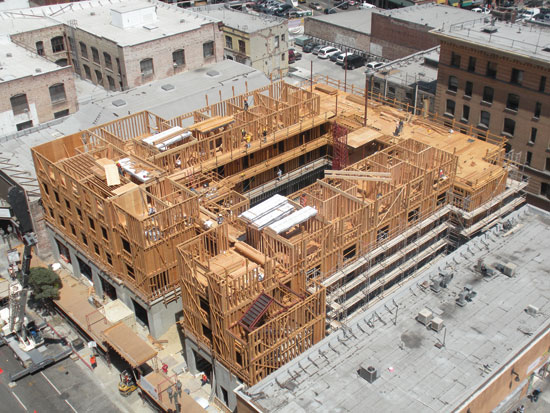Designing for High Winds
Structural Wind Loading
Structural wind loading requirements for buildings and other structures are specified in Chapter 16 of the IBC. The wind loading requirements are obtained primarily through reference to ASCE 7-16. The minimum requirements for wind loads must be used in design and are intended to ensure that every building and structure has sufficient strength to resist these loads without any of its structural elements being stressed beyond material strengths prescribed in the code. The code emphasizes that the loads prescribed in Chapter 16 are minimum loads and, in the vast majority of conditions, the use of these loads will result in a safe building. However, the code also recognizes that the designer may, and sometimes must, use higher loads than those prescribed to ensure a safe structure. The commentary to ASCE 7-16 is a good source to be consulted for additional information since it outlines conditions which may result in higher loading.4 In the event that wind speeds specified in the code are exceeded, there is an increased risk of structural damage and possibly failure despite the presence of safety factors in material design standards. For this reason, it is important to ensure that wind loads are properly determined.
Mapped Wind Speeds and Risk Category
Today's maps include more comprehensive analysis of wind speeds for both coastal and non-coastal areas than has ever been available. The ultimate design wind speed, Vult, in miles per hour (mph) for the establishment of wind loads is determined using wind speed maps contained in three IBC Figures: Figure 1609.3(1) for Risk Category II buildings, Figure 1609.3(2) for Risk Category III buildings, figure 1609.3(3) for Risk Category IV buildings, and Figure 1609.3(4) for Risk Category I buildings. Mapped wind speeds are based on the probability of winds attaining speeds in a geographic area, developed from an analysis of wind speed data collected during severe wind events assuming the following reference conditions: a height of 33 ft above grade and flat, open terrain with scattered obstructions (Exposure Category C) averaged over 3 seconds, i.e., 3-second gust wind speed. Over the years, mapping of wind speeds, along with characterizing effect of surrounding terrain, have evolved with research. For example, earlier maps of ASCE 7 and the predecessor model codes incorporated fastest-mile wind speeds, with fastest-mile being the average speed of one mile of air that passes a specific reference point, with gusts accounted for by pressure coefficients.5

Credit: ASCE. Portion of IBC Figure 1609.3(1).
Ultimate Design Wind Speeds, Vult, For Risk Category II Buildings and Other Structures

Photo: New Genesis Apartments, Killefer Flammang Architects, KC Kim, GB Construction
Wood buildings are often characterized by repetitive framing and numerous connections—which provide multiple, often redundant load paths for resistance to wind forces.
Starting with the 2012 IBC, the term “Risk Categories” replaced “Occupancy Categories,” the term used in previous editions. Risk Categories are used to categorize buildings and structures based on their importance and include considerations such as risk to human life and societal need of the building or structure to function during and following an extreme event. Mapped wind speeds for Risk Category III and IV buildings, for which the potential consequence of failure to human life and/or economic impact is greatest, are greater than mapped wind speeds for Risk Category II buildings. Mapped wind speeds for Risk Category II buildings are greater than for Risk Category I buildings, for which the potential consequence of failure to human life and/or economic impact is relatively small. So for proper design, it is critical to identify the risk category of the building or structure when choosing the wind speed map. The mapped wind speeds for Risk Category II buildings are illustrated on page 4. Detailed descriptions of buildings and structures associated with Risk Category I, II, III and IV are described in IBC Table 1604.5.









